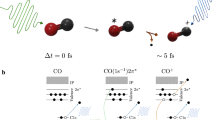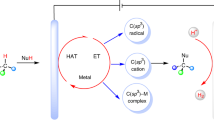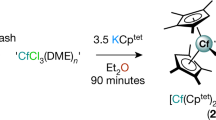Abstract
Covalent bonds share electron pairs between two atoms and make up the skeletons of most organic compounds in single, double and triple bonds. In contrast, examples of one-electron bonds remain scarce, most probably due to their intrinsic weakness1,2,3,4. Although several pioneering studies have reported one-electron bonds between heteroatoms, direct evidence for one-electron bonds between carbon atoms remains elusive. Here we report the isolation of a compound with a one-electron σ-bond between carbon atoms by means of the one-electron oxidation of a hydrocarbon with an elongated C–C single bond5,6. The presence of the C•C one-electron σ-bond (2.921(3) Å at 100 K) was confirmed experimentally by single-crystal X-ray diffraction analysis and Raman spectroscopy, and theoretically by density functional theory calculations. The results of this paper unequivocally demonstrate the existence of a C•C one-electron σ-bond, which was postulated nearly a century ago7, and can thus be expected to pave the way for further development in different areas of chemistry by probing the boundary between bonded and non-bonded states.
This is a preview of subscription content, access via your institution
Access options
Access Nature and 54 other Nature Portfolio journals
Get Nature+, our best-value online-access subscription
$32.99 / 30 days
cancel any time
Subscribe to this journal
Receive 51 print issues and online access
$199.00 per year
only $3.90 per issue
Buy this article
- Purchase on SpringerLink
- Instant access to full article PDF
Prices may be subject to local taxes which are calculated during checkout




Similar content being viewed by others
Data availability
References
Canac, Y. et al. Isolation of a benzene valence isomer with one-electron phosphorus-phosphorus bonds. Science 279, 2080–2082 (1998).
Moret, M., Zhang, L. & Peters, J. C. A polar copper–boron one-electron σ-bond. J. Am. Chem. Soc. 135, 3792–3795 (2013).
Hübner, A. et al. Confirmed by X-ray crystallography: the B⋅B one-electron σ bond. Angew. Chem. Int. Ed. 53, 4832–4835 (2014).
Graziano, B. J. et al. One-electron bonds in copper–aluminum and copper–gallium complexes. Chem. Sci. 13, 6525–6531 (2022).
Ishigaki, Y., Shimajiri, T., Takeda, T., Katoono, R. & Suzuki, T. Longest C–C single bond among neutral hydrocarbons with a bond length beyond 1.8 Å. Chem 4, 795–806 (2018).
Shimajiri, T. The Nature of Ultralong C–C Bonds (Springer Nature, 2023).
Pauling, L. The nature of the chemical bond. II. The one-electron bond and the three-electron bond. J. Am. Chem. Soc. 53, 3225–3237 (1931).
Lewis, G. N. The atom and the molecule. J. Am. Chem. Soc. 38, 762–785 (1916).
Langmuir, I. The arrangement of electrons in atoms and molecules. J. Franklin Inst. 187, 359–362 (1919).
Clark, T. Odd-electron .sigma. bonds. J. Am. Chem. Soc. 110, 1672–1678 (1988).
Ioffe, A. & Shaik, S. Ethane cation-radical isomers and their interconversion pathways. Electron shift isomerism in cation radicals. J. Chem. Soc., Perkin Trans. 2 3, 1461 (1993).
Zuilhof, H., Dinnocenzo, J. P., Reddy, C. & Shaik, S. Comparative study of ethane and propane cation radicals by B3LYP density functional and high-level ab initio methods. J. Phys. Chem. 100, 15774–15784 (1996).
de Sousa, D. W. O. & Nascimento, M. A. C. One-electron bonds are not ‘half-bonds’. Phys. Chem. Chem. Phys. 21, 13319–13336 (2019).
Claxton, T. A., Overill, R. E. & Symons, M. C. R. Possible structures for C2H6+ and B2H6− E.S.R. evidence and UHF calculations. Mol. Phys. 27, 701–706 (1974).
DuPont, T. J. & Mills, J. L. Arylborane anions. Electrochemical study. J. Am. Chem. Soc. 97, 6375–6382 (1975).
Hudson, R. L. & Williams, F. Electron spin resonance spectrum of trimethyl borate ([(MeO)3B.cntdot.B(OMe)3]−). A novel .sigma. radical with a one-electron bond. J. Am. Chem. Soc. 99, 7714–7716 (1977).
Kasai, P. H. & McLeod, D. Electron spin resonance study of molecular anions generated in argon matrix at 4°K: ESR spectrum of B2H6−. J. Chem. Phys. 51, 1250–1251 (1969).
Iwasaki, M., Toriyama, K. & Nunome, K. Electron spin resonance study of electronic and geometrical structures of C2H6+ and other simple alkane cations at 4.2 K: possible evidence for Jahn–Teller distortion. J. Am. Chem. Soc. 103, 3591–3592 (1981).
Wang, J. T. & Williams, F. E.S.R. spectra of the hexamethyldisilane and hexamethyldigermane radical cations. J. Chem. Soc. Chem. Commun. 1981, 666–668 (1981).
Shida, T., Kubodera, H. & Egawa, Y. Confirmation of the cation radicals of hexamethylethane and hexamethyldisilane by ESR and other spectroscopy. Chem. Phys. Lett. 79, 179–182 (1981).
Hoefelmeyer, J. D. & Gabbaï, F. P. An intramolecular boron–boron one-electron σ-bond. J. Am. Chem. Soc. 122, 9054–9055 (2000).
Cataldo, L. et al. Formation of a phosphorus–phosphorus bond by successive one-electron reductions of a two-phosphinines-containing macrocycle: crystal structures, EPR, and DFT investigations. J. Am. Chem. Soc. 123, 6654–6661 (2001).
Rao, V. R. & Hixson, S. S. Arylcyclopropane photochemistry. Electron-transfer-mediated photochemical addition of methanol to arylcyclopropanes. J. Am. Chem. Soc. 101, 6458–6459 (1979).
Dinnocenzo, J. P., Todd, W. P., Simpson, T. R. & Gould, I. R. Nucleophilic cleavage of one-electron .sigma. bonds: stereochemistry and cleavage rates. J. Am. Chem. Soc. 112, 2462–2464 (1990).
Miyashi, T., Ikeda, H., Konno, A., Okitsu, O. & Takahashi, Y. Photoinduced electron-transfer reactions of the cope and related systems. Pure Appl. Chem. 62, 1531–1538 (1990).
Ikeda, H. et al. Photoinduced electron-transfer degenerate cope rearrangement of 2,5-diaryl-1,5-hexadienes: a cation-radical cyclization–diradical cleavage mechanism. J. Am. Chem. Soc. 120, 87–95 (1998).
Ikeda, H. et al. Photoinduced electron-transfer cope rearrangements of 3,6-diaryl-2,6-octadienes and 2,5-diaryl-3,4-dimethyl-1,5-hexadienes: stereospecificity and an unexpected formation of the bicyclo[2.2.0]hexane derivatives. J. Org. Chem. 64, 1640–1649 (1999).
Ikeda, H., Hoshi, Y. & Miyashi, T. 1,3-Bis(4-methoxyphenyl)cyclohexane-1,3-diyl cation radical: divergent reactivity depending upon electron-transfer conditions. Tetrahedron Lett. 42, 8485–8488 (2001).
Gomberg, M. Triphenylmethyl, ein Fall von dreiwerthigem Kohlenstoff. Ber. Dtsch. Chem. Ges. 33, 3150–3163 (1900).
Gomberg, M. An instance of trivalent carbon: triphenylmethyl. J. Am. Chem. Soc. 22, 757–771 (1900).
Kahr, B., Van Engen, D. & Mislow, K. Length of the ethane bond in hexaphenylethane and its derivatives. J. Am. Chem. Soc. 108, 8305–8307 (1986).
Takeda, T. et al. Hexaphenylethanes with an ultralong C–C bond: expandability of the C–C bond in highly strained tetraarylpyracenes. Chem. Lett. 42, 954–962 (2013).
Suzuki, T. et al. Expandability of ultralong C–C bonds: largely different C1–C2 bond lengths determined by low-temperature X-ray structural analyses on pseudopolymorphs of 1,1-bis(4-fluorophenyl)-2,2-bis(4-methoxyphenyl)pyracene. Chem. Lett. 43, 86–88 (2014).
Shimajiri, T., Suzuki, T. & Ishigaki, Y. Flexible C–C bonds: reversible expansion, contraction, formation, and scission of extremely elongated single bonds. Angew. Chem. Int. Ed. 59, 22252–22257 (2020).
Dyker, G., Hagel, M., Henkel, G. & Köckerling, M. Naphthyl-substituted carbocations: from peri interaction to cyclization. Eur. J. Org. Chem. 2008, 3095–3101 (2008).
Cordoneanu, A., Drewitt, M. J., Bavarian, N. & Baird, M. C. Synthesis and characterization of weakly coordinating anion salts of a new, stable carbocationic reagent, the dibenzosuberenyl (dibenzotropylium) ion. New J. Chem. 32, 1890 (2008).
Nishiuchi, T. et al. Anthracene‐attached persistent tricyclic aromatic hydrocarbon radicals. Chem. Asian J. 14, 1830–1836 (2019).
Sun, D., Rosokha, S. V. & Kochi, J. K. Donor-acceptor (electronic) coupling in the precursor complex to organic electron transfer: intermolecular and intramolecular self-exchange between phenothiazine redox centers. J. Am. Chem. Soc. 126, 1388–1401 (2004).
Small, D. et al. Intermolecular π-to-π bonding between stacked aromatic dyads. Experimental and theoretical binding energies and near-IR optical transitions for phenalenyl radical/radical versus radical/cation dimerizations. J. Am. Chem. Soc. 126, 13850–13858 (2004).
Nojo, W., Ishigaki, Y., Takeda, T., Akutagawa, T. & Suzuki, T. Selective formation of a mixed-valence state from linearly bridged oligo(aromatic diamines): drastic structural change into a folded columnar stack for half-filled polycations. Chem. Eur. J. 25, 7759–7765 (2019).
Casado, J. et al. Evidence for multicenter bonding in dianionic tetracyanoethylene dimers by Raman spectroscopy. Angew. Chem. Int. Ed. 52, 6421–6425 (2013).
Kubo, T. et al. Long carbon-carbon bonding beyond 2 Å in Tris(9-fluorenylidene)methane. J. Am. Chem. Soc. 143, 14360–14366 (2021).
Dutan, C. et al. Electron transfer between two silyl-substituted phenylene rings: EPR/ENDOR spectra, DFT calculations, and crystal structure of the one-electron reduction compound of a Di(m-silylphenylenedisiloxane). J. Am. Chem. Soc. 125, 4487–4494 (2003).
Frisch, J. M. et al. Gaussian 16, Revision C.01 (Gaussian, Inc., 2019).
Lu, T. & Chen, F. Multiwfn: a multifunctional wavefunction analyzer. J. Comput. Chem. 33, 580–592 (2012).
Glendening, E. D., Reed, A. E., Carpenter, J. E. & Weinhold, F. NBO v.3.1 (Gaussian, Inc., 2001).
Dolomanov, O. V., Bourhis, L. J., Gildea, R. J., Howard, J. A. K. & Puschmann, H. OLEX2: a complete structure solution, refinement and analysis program. J. Appl. Crystallogr. 42, 339–341 (2009).
Sheldrick, G. M. SHELXT – Integrated space-group and crystal-structure determination. Acta Crystallogr. A Found. Adv. 71, 3–8 (2015).
Sheldrick, G. M. Crystal structure refinement with SHELXL. Acta Crystallogr. C Struct. Chem. 71, 3–8 (2015).
Acknowledgements
We thank E. Fukushi and Y. Takata (Hokkaido University) for recording mass spectra, H. Hirata (Hokkaido University) for recording electron spin resonance spectra, S. Noro, Y. Saito and A. Yamazaki for recording solid-state UV/Vis/NIR spectra, as well as J. P. Gong and T. Nakajima for recording solid-state IR spectra. Parts of the theoretical calculations were carried out at the Research Center for Computational Science, Okazaki, Japan (Project 23-IMS-C218). We would also like to thank U. F. J. Mayer at www.mayerscientificediting.com for proofreading our manuscript. This work was supported by the Masason Foundation (to S.K.) and by the Research Program ‘Five-star Alliance’ in ‘NJRC Mater. & Dev.’ of MEXT (Japan). Y. I. and T. Shimajiri acknowledge financial support from a Toyota Riken Scholarship. This work was furthermore supported by Grants-in-Aid from MEXT (JSPS Nos. 23K13726 to T. Shimajiri, 23K20275 to T. Suzuki, and 23K21107 and 23H04011 to Y.I.) and JST PRESTO (No. JPMJPR23Q1) to Y.I.
Author information
Authors and Affiliations
Contributions
T. Shimajiri, T. Suzuki and Y.I. developed the concept of this study. T. Shimajiri and S.K. conducted the synthetic and spectroscopic experiments as well as the theoretical calculations. T. Shimajiri, T. Suzuki and Y.I. supervised the project. T. Shimajiri prepared the manuscript with feedback from all authors.
Corresponding authors
Ethics declarations
Competing interests
The authors declare no competing interests.
Peer review
Peer review information
Nature thanks Tobias Krämer and the other, anonymous, reviewer(s) for their contribution to the peer review of this work. Peer reviewer reports are available.
Additional information
Publisher’s note Springer Nature remains neutral with regard to jurisdictional claims in published maps and institutional affiliations.
Supplementary information
Rights and permissions
Springer Nature or its licensor (e.g. a society or other partner) holds exclusive rights to this article under a publishing agreement with the author(s) or other rightsholder(s); author self-archiving of the accepted manuscript version of this article is solely governed by the terms of such publishing agreement and applicable law.
About this article
Cite this article
Shimajiri, T., Kawaguchi, S., Suzuki, T. et al. Direct evidence for a carbon–carbon one-electron σ-bond. Nature 634, 347–351 (2024). https://doi.org/10.1038/s41586-024-07965-1
Received:
Accepted:
Published:
Issue date:
DOI: https://doi.org/10.1038/s41586-024-07965-1
This article is cited by
-
A crystalline dithorium complex with a Th–Th bond
Nature Synthesis (2025)
-
Emergent clusteroluminescence from nonemissive molecules
Nature Communications (2025)
-
Exploring the boundaries of covalency
Nature Reviews Chemistry (2024)
-
Carbon bond that uses only one electron seen for first time: ‘It will be in the textbooks’
Nature (2024)




Henry Rzepa
In this region of sub two-electron bonds, there is much scope for a continuum of interactions, ranging from "strong" to "weak". The example identified in this article might be classified as of the weak non-covalent interaction type, as revealed by an NCI (non-covalent-interaction) analysis. See DOI: https://doi.org/10.59350/xp5a3-zsa24 for this analysis. Model one-electron bonds formed from e.g. hexafluoroethane and ethane itself have much shorter C-C bonds, down to 1.93A for the latter, and appear to be closer to the covalent bond type than the interaction type. This is supported by the properties of the electron density Laplacian. See DOI: https://doi.org/10.59350/88k04-2x509 Thus the one-electron C-C bond can apparently sustain lengths differing by as much as ~1Å, a much larger variation than any higher electron C-C bonds.